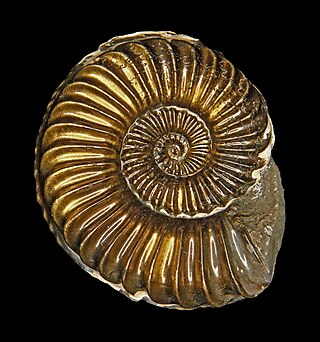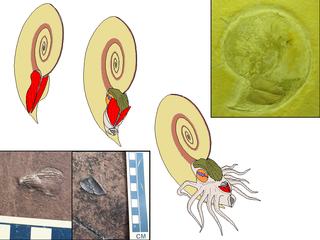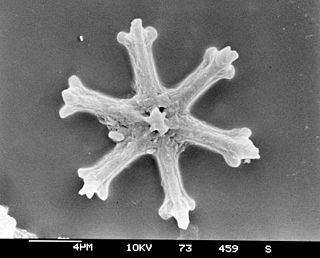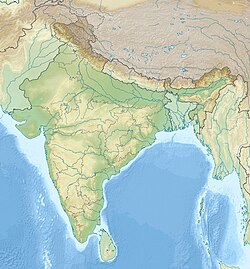
Ammonoids are extinct spiral shelled cephalopods comprising the subclass Ammonoidea. They are more closely related to living coleoids than they are to shelled nautiloids. The earliest ammonoids appeared during the Devonian, with the last species vanishing during or soon after the Cretaceous–Paleogene extinction event. They are often called ammonites, which is most frequently used for members of the order Ammonitida, the only remaining group of ammonoids from the Jurassic up until their extinction.

Micropaleontology is the branch of paleontology (palaeontology) that studies microfossils, or fossils that require the use of a microscope to see the organism, its morphology and its characteristic details.

The siphuncle is a strand of tissue passing longitudinally through the shell of a cephalopod mollusk. Only cephalopods with chambered shells have siphuncles, such as the extinct ammonites and belemnites, and the living nautiluses, cuttlefish, and Spirula. In the case of the cuttlefish, the siphuncle is indistinct and connects all the small chambers of that animal's highly modified shell; in the other cephalopods it is thread-like and passes through small openings in the septa (walls) dividing the camerae (chambers). Some older studies have used the term siphon for the siphuncle, though this naming convention is uncommon in modern studies to prevent confusion with a mollusc organ of the same name.

The Chalk Group is the lithostratigraphic unit which contains the Upper Cretaceous limestone succession in southern and eastern England. The same or similar rock sequences occur across the wider northwest European chalk 'province'. It is characterised by thick deposits of chalk, a soft porous white limestone, deposited in a marine environment.

An aptychus is a type of marine fossil. It is a hard anatomical structure, a sort of curved shelly plate, now understood to be part of the body of an ammonite. Paired aptychi have, on rare occasions, been found at or within the aperture of ammonite shells. The aptychus was usually composed of calcite, whereas the ammonite shell was aragonite.

The Aptian is an age in the geologic timescale or a stage in the stratigraphic column. It is a subdivision of the Early or Lower Cretaceous Epoch or Series and encompasses the time from 121.4 ± 1.0 Ma to 113.0 ± 1.0 Ma, approximately. The Aptian succeeds the Barremian and precedes the Albian, all part of the Lower/Early Cretaceous.

The Carnian is the lowermost stage of the Upper Triassic Series. It lasted from 237 to 227 million years ago (Ma). The Carnian is preceded by the Ladinian and is followed by the Norian. Its boundaries are not characterized by major extinctions or biotic turnovers, but a climatic event occurred during the Carnian and seems to be associated with important extinctions or biotic radiations. Another extinction occurred at the Carnian-Norian boundary, ending the Carnian age.

In the geologic time scale, the Changhsingian or Changxingian is the latest age or uppermost stage of the Permian. It is also the upper or latest of two subdivisions of the Lopingian Epoch or Series. The Changhsingian lasted from 254.14 to 251.9 Ma ago. It is preceded by the Wuchiapingian age/stage and is followed by the Induan age/stage.

The Glen Rose Formation is a shallow marine to shoreline geological formation from the lower Cretaceous period exposed over a large area from South Central to North Central Texas. The formation is most widely known for the dinosaur footprints and trackways found in the Dinosaur Valley State Park near the town of Glen Rose, Texas, southwest of Fort Worth and at other localities in Central Texas.

The taxonomy of commonly fossilized invertebrates combines both traditional and modern paleozoological terminology. This article compiles various invertebrate taxa in the fossil record, ranging from protists to arthropods. This includes groups that are significant in paleontological contexts, abundant in the fossil record, or have a high proportion of extinct species. Special notations are explained below:
Girvanella is a fossil thought to represent the calcified sheath of a filamentous cyanobacterium known from the Burgess Shale and other Cambrian fossil deposits. Specimens are also known from the Early Ordovician San Juan Formation, Argentina.
The Vanguard Formation is a stratigraphical unit of Callovian to Oxfordian age in the Western Canadian Sedimentary Basin.

The Hoko River Formation is a Late Eocene marine sedimentary geologic formation. The formation is exposed in outcrops along the Strait of Juan de Fuca on the Olympic Peninsula in Washington state, USA. It is known for containing numerous fossils of crabs. It overlies the older Lyre Formation and underlies the younger Makah Formation.
The Río Hatillo Formation is a geologic formation in Dominican Republic. It preserves bivalve, echinoid, gastropod and ammonite fossils dating back to the Early Albian period.
The Mount Peace Formation is a geologic formation in Jamaica. It preserves ammonite, bivalve and echinoid fossils dating back to the Late Santonian stage of the Cretaceous period.

The Trincheras Formation is a geological formation of the Altiplano Cundiboyacense, Eastern Ranges of the Colombian Andes. The formation consisting of a lower unit of calcareous shales and an upper sequence of shales dates to the Early Cretaceous period; Early Aptian epoch and has a maximum thickness of 1,260 metres (4,130 ft). The formation, deposited in a marine platform environment, part of a transgressive cycle, hosts ammonite, bryozoan, mollusc and echinoid fossils.

Leyvachelys is an extinct genus of turtles in the family Sandownidae from the Early Cretaceous of the present-day Altiplano Cundiboyacense, Eastern Ranges, Colombian Andes. The genus is known only from its type species, Leyvachelys cipadi, described in 2015 by Colombian paleontologist Edwin Cadena. Fossils of Leyvachelys have been found in the fossiliferous Paja Formation, close to Villa de Leyva, Boyacá, after which the genus is named. The holotype specimen is the oldest and most complete sandownid turtle found to date.
The island of Bonaire began to form as part of the Lesser Antilles island arc in the past 145 million years, beginning in the Cretaceous. The island has been submerged or partially submerged for much of its existence, forming large limestone and sedimentary rock formations, atop a thick basement of volcanic rocks.

The Jagüel Formation is a geological formation, located in Patagonia, Argentina. It underlies the Roca Formation and overlies the Allen Formation. All of these formations belong to the Malargüe Group. Its name was coined by Windhausen in 1914. This unit, defined in the eastern area of the Neuquén Embayment, registers an event of marine flooding that happened during the ages Maastrichtian and Danian. It consists of mudrocks formed between the upper section or "Gypsum" of the Allen Formation, and the base of the first organogenic limestone of the Roca Formation. The Jagüel Formation is particularly important since a vast area of the formation contains the Cretaceous–Paleogene boundary that marks the end of the Mesozoic Era. It also shows evidence of the Cretaceous–Paleogene (K–Pg) extinction event. In this period of time, animal species became extinct, such as non–avian dinosaurs, the last marine reptiles, ammonites, and many groups of microfossils.

Calcareous nannofossils are a class of tiny microfossils that are similar to coccoliths deposited by the modern-day coccolithophores. The nannofossils are a convenient source of geochronological data due to the abundance and rapid evolution of the single-cell organisms forming them (nannoplankton) and ease of handling of the sediment samples. The practical applications of calcareous nannofossils in the areas of biostratigraphy and paleoecology became clear once the deepwater drilling took off in 1968 with the Deep Sea Drilling Project, and they have been extensively studied ever since. Nannofossils provide one of the most important paleontological records with the contiguous length of 220 million years.
















